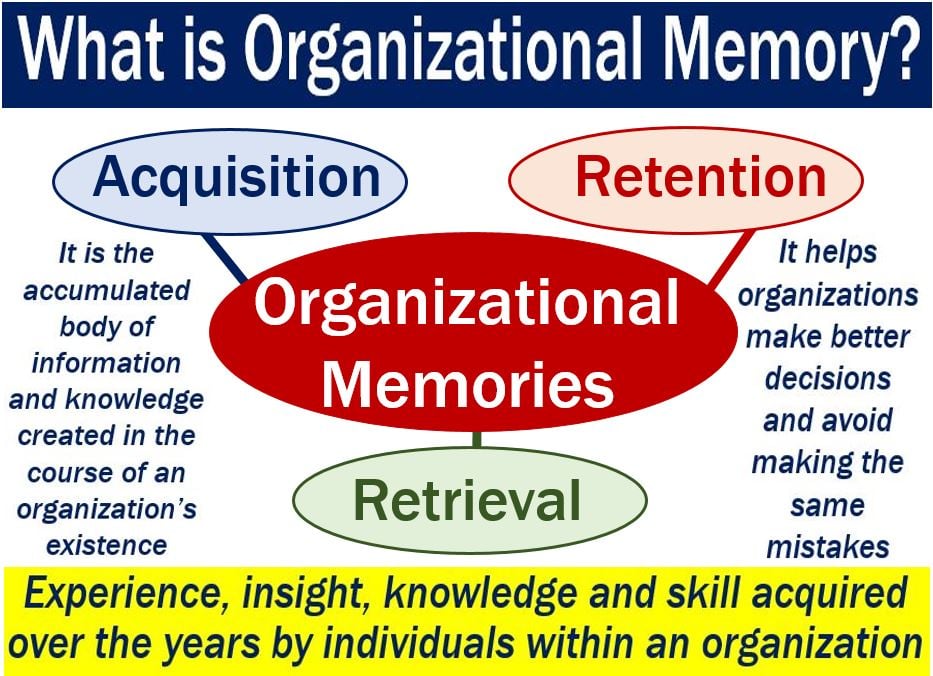Organizational memory refers to the collective ability to accumulate, store, and retrieve knowledge and data. Human memory is all about our ability to gain, store, and retrieve data. Organizational memory, however, extends beyond the individual. In other words, it refers to companies and other organizations.
An organization is any organized group of people who work together and have a common goal. They coordinate their activities.
Institutional memory or corporate memory mean the same as organizational memory. In this article, I use the three terms interchangeably. Institutional memory consists of information; specifically, information which is of value for re-use.
Organizational memory is mainly undocumented insights, experience, skills, and knowledge acquired over time.
Current employees pass on this information to new employees through meetings, training courses, and personal contacts. This type of memory also develops as a result of mentor-protégé relationships.
Organizational memory repositories
Organizational memory has two repositories: the archives of the organization, and individual people’s memories. With the term archives, we also include the organization’s electronic databases.
Organizational memory typically vanishes through frequent layoffs, employee attrition, disasters, and excessive downsizing. Downsizing refers to trimming a company. In other words, reducing the size of a company’s operating costs.
James Walsh, from Dartmouth College, and Gerardo Ungson, from the University of Oregon, defined organizational memory as:
“The information stored by the history of an organization that can influence the present decisions of the organizations.”

Organizational memory – three stages
In the corporate memory process, there are three stages. The stages are essential to the organization’s learning process. The main stages are acquisition, retention, and retrieval.
Acquisition
Organizational memory contains the accumulated information on past decisions. However, companies, for example, do not store this data centrally. They store it across several retention facilities.
Each time employees make a decision, they also evaluate the consequences of those decisions. They then add some of the data regarding the consequences to the corporate memory.
Retention
There are five different repositories where organizations retain information about past experiences. They are Individuals, Culture, Transformations, Structures, and External Activities.
Culture refers to the frameworks and language that organizations have. We form shared interpretations with them.
Transformations refers to the formalized systems and procedures that the organization uses. In fact, these systems reflect the organization’s past experiences. They contain embedded knowledge.
Structures link people to each other, as well as to the environment.
External activities are the organization’s surroundings, where data can be stored. For example, competitors, ex-employees, and government bodies.
Retrieval
Humans access and use past experiences to avoid making the same mistakes again. We also access and use past experiences to exploit valuable knowledge. Organizations do the same.
However, corporate memory, unlike human memory, does not exist in just one repository. It resides throughout the organization. In fact, it even resides outside it.
How people retrieve that knowledge or data varies. For example, if we have written it down, we can access it from electronic records.
Other languages
Here is the term Organizational Memory in some other languages:
- Memoria Organizacional (Spanish)
- Mémoire Organisationnelle (French)
- Organisationsgedächtnis (German)
- Memoria Organizzativa (Italian)
- Organisatoriskt Minne (Swedish)
- Организационная Память (Russian)
- 组织记忆 (Zǔzhī Jìyì) (Mandarin Chinese)
- الذاكرة التنظيمية (Al-dhakira At-tanẓīmīya) (Arabic)
- संगठनात्मक स्मृति (Sangathanatmak Smriti) (Hindi)
- Organizační Paměť (Czech)
- Organisatiegeheugen (Dutch)
- Pamięć Organizacyjna (Polish)
- Memória Organizacional (Portuguese)
- Hafıza Örgütsel (Turkish)
- 組織の記憶 (Soshiki no Kioku) (Japanese)
- 조직 기억 (Jojik Gieok) (Korean)
- সংগঠনিক স্মৃতি (Sônggôthonik Smriti) (Bengali)
- Organisasional Memori (Javanese)
- ਸੰਗਠਨਾਤਮਕ ਮੈਮੋਰੀ (Sangathanatmak Memory) (Punjabi)
